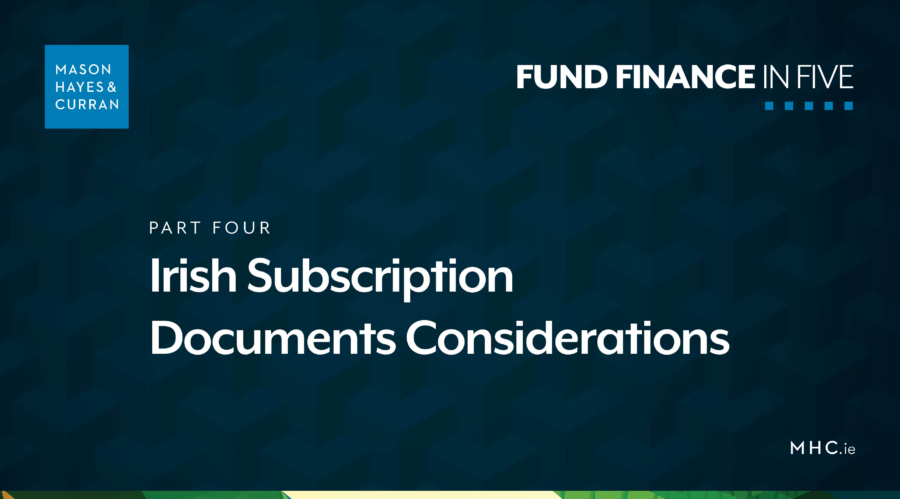Irish Fund Finance in Five – Part 4
Irish Subscription Documents Considerations

Download full Fund Finance in Five series
Ireland is currently home to over 8,880 funds with over €4.9 trillion in net assets. More than 1,000 fund managers from over 50 different countries have assets administered in Ireland, including 17 of the top 20 global asset managers. As a destination for fund managers, Ireland offers access to the EU-wide marketing passport for UCITS and AIFs. Accordingly, Ireland is established as a domicile of choice for the global investment funds industry and the fund industry in Ireland continues to grow year on year.
In addition to the growth of the Irish investment funds industry, the global fund finance industry has experienced rapid growth over the last number of years. The fund finance industry has proven itself to be robust and withstood a number of external market factors and periods of volatility, such as:
- The current higher interest environment
- The exit of certain market participants, and
- Onerous capital requirements for financial institutions
As both the Irish investment funds industry and the global fund finance industry continues to grow, naturally the number of fund finance transactions involving Irish vehicles also continues to grow. Over time, Ireland has proven itself to be a convenient jurisdiction in which to conduct fund finance transactions. With its English-speaking population and its common law legal system, market participants based from other jurisdictions (such as the UK and the US) often find transactions involving an Irish nexus to be convenient and familiar.
We have prepared this “Irish Fund Finance in Five” series to act as a comprehensive overview of all things Irish law related in the fund finance market. This series will be split into five parts, consisting of:
- Part 1 – Common Irish Legal Issues in Fund Financings
- Part 2 – Irish Security Considerations
- Part 3 – Irish Legal Due Diligence Considerations
- Part 4 - Irish Subscription Documents Considerations
- Part 5 – Overview of Irish Fund Structures
The issues examined by us in this series act only as a summary and are not intended to be exhaustive. As readers will appreciate, this series should not be considered a substitute for legal advice and lenders and funds should engage legal counsel at the outset of a transaction to ensure that these issues are given appropriate consideration.
Download full Fund Finance in Five series
Introduction
In Part 4 of our 'Irish Fund Finance in Five' series, we examine some of the typical provisions of investor subscription documents in Irish funds. We also explore the issues certain provisions in these documents can cause in the context of subscription line facilities. While we have seen an increase in Net Asset Value (NAV)-based financing facilities and hybrid facilities, based on our recent experience, subscription line facilities still make up the majority of fund finance transactions made available to Irish fund borrowers.
Over the years, subscription line facilities have proven to be reliable investments for lenders. Despite this, it is important for lenders to carry out robust due diligence on the investor pool and subscription documents before advancing any facility.
One of the main areas of due diligence for prospective lenders will focus on the identity and creditworthiness of the investor pool. This 'financial' due diligence needs to be coupled with thorough legal due diligence regarding the proposed transaction. In Part 3 of our “Irish Fund Finance in Five” series, we examined legal due diligence issues that arise for all fund finance transactions involving lending to Irish fund borrowers, which would be equally applicable to subscription line facilities. In Part 4, we delve deeper into legal due diligence issues and considerations specifically concerning subscription documentation.
When conducting legal due diligence regarding a fund’s pool of investors and the associated subscription documents, we would typically expect to review:
- The fund’s constitutional document, which may take the form of an instrument of incorporation, memorandum and articles of association, limited partnership agreement, trust deed or deed of constitution depending on the type of fund vehicle
- The primary investor subscription document, and
- Any side letters that have been put in place with specific investors
Typical provisions which we would review and issues that we would encounter when reviewing these documents are set out below. For the purposes of this section, we have assumed that the subscription documents are governed by Irish law.
1. Creating security over uncalled capital commitments
Ideally, the subscription documents will expressly acknowledge that security may be created over the uncalled commitments in connection with any banking facility made available to the fund borrower. However, at a minimum, the subscription documents will need to be reviewed to ensure that they do not have any prohibition on assignment and/or the granting of security. Where these or similar restrictions are in place, the relevant investors will need to consent to the creation of any security. From a practical perspective, it may be most convenient to build this wording into the acknowledgement of assignment regarding the creation of security over capital commitments that is to be signed by the investors. This would add a layer of administrative burden, as from an Irish law perspective, these acknowledgements are not needed to perfect a security interest – from an Irish law perspective, the security interest is perfected through delivery of the notice of security. This approach will obviously have an impact on timing for a transaction. As a result, any restrictions ought to be identified at an early stage to allow time for the issue to be resolved. Alternatively, the lender may adjust its security package or simply exclude certain relevant investors from the fund’s borrowing base.
2. Process for making calls
Generally, the fund acting through its directors, general partner or manager will be the party that is entitled to issue capital calls to investors. However, this role may be delegated to a third-party service provider. Since the security documents for a subscription line facility will typically provide for an assignment of the right to make capital calls, any third party delegated these rights should also be a party to the security document assigning them.
Investor subscription documents may also provide that a fund can only make capital calls in specific circumstances or for specific purposes. For lenders, it is important to ascertain whether capital calls can be made in order to repay principal debt of the fund and any interest accrued. Ideally, the documentation will include wording making it clear that an investor is still required to contribute capital when the fund is insolvent.
Typically, the fund documents will provide for certain circumstances where the calculation of the fund’s net asset value will be suspended. During any related suspension period, investors will be prevented from redeeming their units or shares in the fund. A NAV suspension can have a knock-on effect by restricting the fund or the relevant third party’s right to make capital calls from investors during the suspension period. This restriction could prevent or delay a lender from enforcing its security over uncalled commitments. Ultimately, these suspension provisions will need to be reviewed in detail for each transaction. It may also be necessary for amendments to the subscription documents or side letters with the investors.
3. Set-off rights
An investor’s obligation to fund capital calls may be capable of being reduced or set-off by claims which that investor can exercise against the fund. Ideally, the subscription documents will provide that the investor may not exercise these rights where required to fund a repayment of a subscription line facility. Where this right has not been disapplied, it could result in a shortfall in the value of its security package, which would likely adversely impact the secured parties.
Serving a notice of assignment of capital call rights on the relevant investors should prevent set-offs from arising after the notice is served. However, this approach will not set aside set-offs that arose before the date of service. Depending on the circumstances of the transaction, lenders may look to put in place side letters, whereby the investors waive their rights of set-off and any pre-existing claims of set-off against the fund.
4. Excuse rights
In certain scenarios, investors may be relieved or ‘excused’ of their obligation to make capital contributions to the fund. For example, certain investors may be excused where the fund is investing in a particular type of asset, such as gambling products. Where excuse rights are in place, lenders should look to ensure that the repayment of the principal and interest arising under the loan facility does not result in the fund’s investors being excused from their funding obligations.
5. Overcall/defaulting investor provisions
Typically, where an investor has defaulted or is excused from making a capital contribution, overcall provisions allow a fund to make capital calls from the non-defaulting/non-excused investors to make up the shortfall. In certain circumstances, these ‘overcall’ obligations of investors may be subject to a cap.
Given that the investor commitments form the security on which the loan is advanced and the means by which advances will ultimately be repaid, it is important for lenders to understand the overcall provisions, including any restrictions on overcalling. In an enforcement scenario, where one investor is excused or has defaulted, the lenders will need to rely on these overcall provisions to ensure repayment of the indebtedness.
A well-drafted security document should encompass security over any overcall rights against the investors.
6. Recallable distributions
Subscription documents may provide that, in certain circumstances, distributions made to a fund’s investors are capable of being ‘recalled’, meaning they can be returned to the fund. For lenders, it can be desirable for capital recalls to be permitted for the purpose of repaying principal amounts on outstanding loans and accrued interest. For obvious reasons, this may be resisted by investors. Lenders will also consider whether any recallable capital should increase the amount of unused capital commitments of investors.
7. Transfer and withdrawal rights
Investor subscription documents may grant investors the ability to transfer their interests in the fund or indeed to withdraw their interest in the fund entirely. This may take the form of an outright permission to transfer or withdraw their interest without giving notice to the fund, the ability to do so with sufficient notice to the fund, or a permission to do so in certain circumstances.
For subscription line facilities, the identity and creditworthiness of a fund’s pool of investors is the key factor for a lender in assessing its credit risk concerning the relevant loan facility. On this basis, a lender should ideally be made aware of circumstances which may cause the fund’s pool of investors to change from that which the lender used as its borrowing base when making the facilities available. One of the key commercial points for negotiation will be whether the lender will have consent rights prior to any investor transfer and/or whether any replacement investor is counted towards the borrowing base.
8. Most-favoured nation (MFN) provisions
As readers will be aware, MFN provisions are generally outlined in a side letter between the relevant investor and the fund. These provisions grant that investor the right to access more favourable rights or privileges compared to other investors. In some circumstances, investors may be given the ability to view the side letters of other investors to determine whether those letters contain any MFN provisions. Where MFN provisions are in place, it is imperative that detailed due diligence is carried out on the investor side letters. This approach will ensure that their existence does not result in a broader group of investors being able to access these rights to the detriment of the fund and the lender.
9. Investor side letters
In any given transaction, particularly where institutional investors are investing into an Irish fund vehicle, there may be investor side letters that are put in place with certain investors. These side letters provide the relevant investor with bespoke rights, outside of those which are contained within the fund’s general subscription agreement. These side letters may grant an investor any of the rights examined above. As a result, all existing side letters should be examined thoroughly by lender counsel during the legal due diligence process.
There may also be other unique provisions set out within individual side letters, such as provisions which alter the transfer and withdrawal rights of specific investors and confidentiality protections. Each of these factors may require changes to be made to transaction documents to ensure that these rights do not cut across the lender’s security over the investor’s commitments and that these protections are not breached. Certain types of investors, such as national pension funds or sovereign wealth funds, may have sovereign immunity protections which should be disapplied. These provisions may have a direct impact on the enforceability of a lender’s security package, particularly its ability to enforce its right to make capital calls from investors.
Where the underlying documentation is deficient from a lender’s perspective, it is common for a lender in such a circumstance to require side letters to be put in place with the investors to bolster the enforceability of its security over the uncalled commitments. Where an investor has been granted rights that conflict with the lender’s security package, such as the rights examined above, a side letter may be entered into between the fund, the investor, and the relevant lender. This side letter would provide that the investor’s rights shall be waived or subordinated to the lender’s security interest in the investor’s capital commitments and its right to make capital calls from the investor in an enforcement scenario.
On a similar note, in some private credit fund structures involving a S.110 company, the method of investment can take the form of a profit participating note (PPN). In those circumstances, the debt under that PPN should be expressed to be subordinated to the subscription line lender’s interests.
10. General information
While the issues mentioned above cover bespoke provisions that lender’s counsel should look out for, there is also more formulaic information within subscription documents which lenders ought to be aware of. The names of the investors within the subscription documents should be examined by a lender, as fund managers often use lists which contain abbreviations of investor names when listing them within the underlying subscription documents. Lenders and their counsel should seek to confirm the names of all investors with the fund manager before the transaction documents are executed. A failure to do so can result in the lender assuming that certain investors were part of the investor pool when they were not, and also taking and registering its security against the incorrect parties.
Subscription documents will state the amount of each investor’s capital commitment to the fund. The fund manager should also have provided a list of investors which indicates the total amounts committed by each investor. These lists should be cross checked to ensure that the amounts match up and that the capital commitments of the fund’s borrowing base are at the levels which the lender expected.
It should also be determined whether the investors have in fact committed their capital to the borrower fund. Typically, fund structures on cross border transactions involve various funds and sub-funds. Therefore, lenders ought to be certain that investors have contractually committed their commitments to the borrower fund, rather than a separate fund within the structure.
The capital commitment agreements of specific investors should be examined to make sure that they have been correctly executed by each investor. If not, the capital commitment obligations of the relevant investors may not be enforceable, which would obviously reduce the value of the lender's security package.
Conclusion
The legal due diligence carried out in connection with a subscription line facility should establish two main principles. Firstly, that the borrower fund has enforceable capital commitments against its investors. Secondly, that the secured parties have enforceable security against those capital commitments. As such, a comprehensive review of the subscription documents should be carried out at the beginning of any subscription line financing.
For more information and expert advice, please reach out to a member of our Fund Finance team. Stay tuned for the remaining issue of our ‘Fund Finance in Five’ series.
The content of this article is provided for information purposes only and does not constitute legal or other advice.
Share this:




